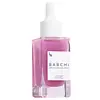What's inside
What's inside
 Key Ingredients
Key Ingredients

 Benefits
Benefits

 Concerns
Concerns

No concerns
 Ingredients Side-by-side
Ingredients Side-by-side

Water
Skin ConditioningPPG-13-Decyltetradeceth-24
EmulsifyingMethylpropanediol
SolventButylene Glycol
HumectantBakuchiol
AntimicrobialSalicylic Acid
MaskingCentella Asiatica Extract
CleansingLactobacillus/Collagen/Mesembryanthemum Crystallinum Leaf Extract Ferment Lysate
Skin ConditioningAmylopectin
Propylene Glycol
HumectantXanthan Gum
EmulsifyingDextrin
AbsorbentPolyglutamic Acid
Skin ConditioningSodium Hyaluronate
HumectantHydrolyzed Hyaluronic Acid
HumectantSodium Acetylated Hyaluronate
HumectantHydroxypropyltrimonium Hyaluronate
Glycerin
HumectantCystoseira Tamariscifolia Extract
Skin ConditioningGlycyrrhiza Glabra Root Extract
BleachingGlabridin
BleachingBenzoic Acid
MaskingEthylhexylglycerin
Skin Conditioning1,2-Hexanediol
Skin ConditioningPhenoxyethanol
PreservativeCI 17200
Cosmetic ColorantCI 42090
Cosmetic ColorantTriethanolamine
BufferingWater, PPG-13-Decyltetradeceth-24, Methylpropanediol, Butylene Glycol, Bakuchiol, Salicylic Acid, Centella Asiatica Extract, Lactobacillus/Collagen/Mesembryanthemum Crystallinum Leaf Extract Ferment Lysate, Amylopectin, Propylene Glycol, Xanthan Gum, Dextrin, Polyglutamic Acid, Sodium Hyaluronate, Hydrolyzed Hyaluronic Acid, Sodium Acetylated Hyaluronate, Hydroxypropyltrimonium Hyaluronate, Glycerin, Cystoseira Tamariscifolia Extract, Glycyrrhiza Glabra Root Extract, Glabridin, Benzoic Acid, Ethylhexylglycerin, 1,2-Hexanediol, Phenoxyethanol, CI 17200, CI 42090, Triethanolamine
Ingredients Explained
These ingredients are found in both products.
Ingredients higher up in an ingredient list are typically present in a larger amount.
1,2-Hexanediol is a synthetic liquid and another multi-functional powerhouse.
It is a:
- Humectant, drawing moisture into the skin
- Emollient, helping to soften skin
- Solvent, dispersing and stabilizing formulas
- Preservative booster, enhancing the antimicrobial activity of other preservatives
Glycerin is already naturally found in your skin. It helps moisturize and protect your skin.
A study from 2016 found glycerin to be more effective as a humectant than AHAs and hyaluronic acid.
As a humectant, it helps the skin stay hydrated by pulling moisture to your skin. The low molecular weight of glycerin allows it to pull moisture into the deeper layers of your skin.
Hydrated skin improves your skin barrier; Your skin barrier helps protect against irritants and bacteria.
Glycerin has also been found to have antimicrobial and antiviral properties. Due to these properties, glycerin is often used in wound and burn treatments.
In cosmetics, glycerin is usually derived from plants such as soybean or palm. However, it can also be sourced from animals, such as tallow or animal fat.
This ingredient is organic, colorless, odorless, and non-toxic.
Glycerin is the name for this ingredient in American English. British English uses Glycerol/Glycerine.
Learn more about GlycerinWater. It's the most common cosmetic ingredient of all. You'll usually see it at the top of ingredient lists, meaning that it makes up the largest part of the product.
So why is it so popular? Water most often acts as a solvent - this means that it helps dissolve other ingredients into the formulation.
You'll also recognize water as that liquid we all need to stay alive. If you see this, drink a glass of water. Stay hydrated!
Learn more about Water